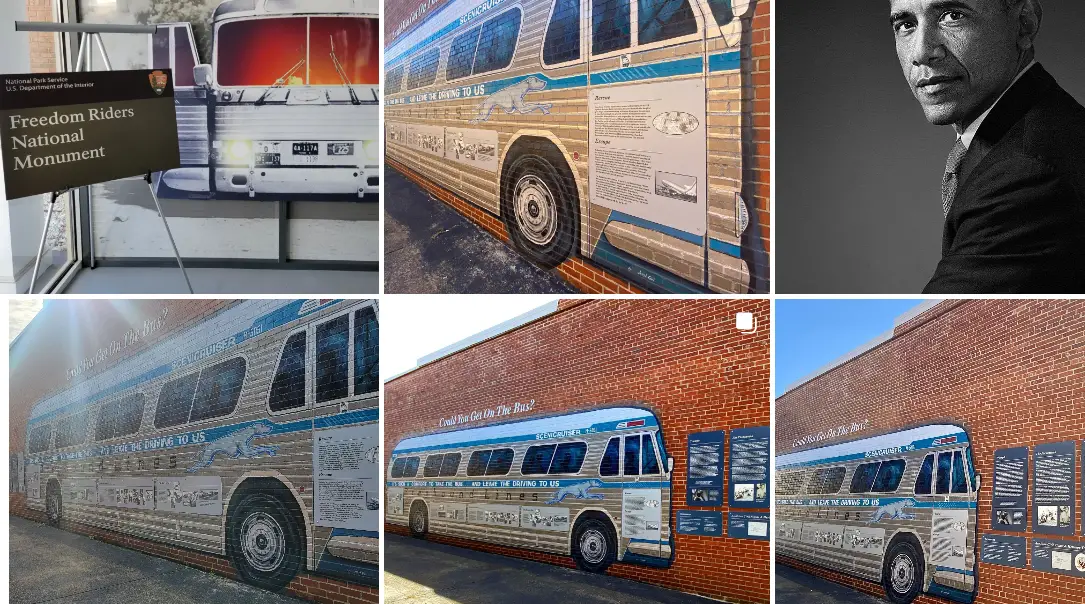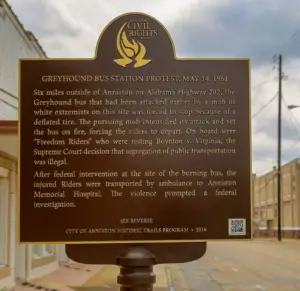Freedom Riders National Monument : Interesting Facts, History & Travel Guide

- By
- Aparna Patel
- |
- 1 Apr, 2023
- |

Freedom Riders National Monument is a powerful testament to the struggle for civil rights in the United States. Located in Anniston, Alabama, the monument commemorates the bravery and sacrifice of the Freedom Riders, a group of activists who traveled throughout the South in 1961 to challenge segregation on interstate buses. The monument marks the site of the infamous attack on a Greyhound bus carrying Freedom Riders, in which the bus was set on fire and the passengers were brutally beaten.
Today, visitors can explore the monument, learn about the history of the Civil Rights Movement, and pay tribute to the brave men and women who risked their lives to fight for justice and equality.
In this blog, we will delve into the fascinating history and explore the interesting facts and travel guide of Freedom Riders National Monument, providing you with all the information you need to plan an unforgettable visit to this remarkable site.
Table of Contents
Interesting facts about Freedom Riders National Monument
Here are some interesting facts about Freedom Riders National Monument:
- Freedom Riders National Monument is located in Anniston, Alabama, and was established by President Barack Obama in 2017. The monument commemorates the Freedom Riders, a group of civil rights activists who challenged segregation in the South during the 1960s.
- The monument includes the Greyhound Bus Station where a violent attack occurred on May 14, 1961. The bus was carrying Freedom Riders who were protesting segregation in interstate travel. The station was designated a National Historic Landmark in 2001.
- The Freedom Riders were a diverse group of activists, including both black and white Americans, who rode buses across the South to challenge segregation. They faced violent attacks, arrests, and imprisonment in their efforts to bring attention to the injustices of segregation.
- The Freedom Rides were organized by the Congress of Racial Equality (CORE) and the Student Nonviolent Coordinating Committee (SNCC) in 1961. The riders aimed to test a Supreme Court ruling that outlawed segregation in interstate travel, but was being ignored in many Southern states.
- The violence that occurred at the Greyhound Bus Station in Anniston on May 14, 1961, included the bombing and burning of a bus, which had a devastating impact on the riders and drew national attention to the cause.
- The Freedom Rides and the violence that accompanied them helped to draw attention to the issue of segregation and spurred the Civil Rights Act of 1964, which outlawed segregation in public places and employment.
- The Freedom Riders National Monument includes a walking trail, a plaque commemorating the bus burning, and exhibits that tell the story of the Freedom Rides and the struggle for civil rights.
- The monument is part of a larger effort to recognize and preserve important sites related to the civil rights movement. Other sites include the Selma to Montgomery National Historic Trail and the Martin Luther King Jr. National Historical Park in Atlanta.
- Freedom Riders National Monument is the first national monument designated during the Obama administration and the first national monument to recognize the civil rights movement.
Information & History of Freedom Riders National Monument
Freedom Riders National Monument is a national monument in Anniston, Alabama, that was established by President Barack Obama in 2017. The monument commemorates the Freedom Riders, a group of civil rights activists who challenged segregation in the South during the 1960s.
The Freedom Rides were a series of bus trips taken by civil rights activists in 1961 to challenge segregation in interstate travel. The riders, organized by the Congress of Racial Equality (CORE) and the Student Nonviolent Coordinating Committee (SNCC), rode buses through the South to test a Supreme Court ruling that outlawed segregation in interstate travel, but was being ignored in many Southern states.
The riders faced violent attacks, arrests, and imprisonment in their efforts to bring attention to the injustices of segregation. On May 14, 1961, a group of Freedom Riders arrived in Anniston, Alabama, where they were met by a violent mob. The mob bombed and burned one of the buses, injuring several of the riders.
The Greyhound Bus Station in Anniston, where the attack occurred, was designated a National Historic Landmark in 2001. In 2017, it was included as part of the newly-established Freedom Riders National Monument.
The monument includes the bus station, a walking trail, and exhibits that tell the story of the Freedom Rides and the struggle for civil rights. It is part of a larger effort to recognize and preserve important sites related to the civil rights movement.
Freedom Riders National Monument is the first national monument designated during the Obama administration and the first national monument to recognize the civil rights movement. It serves as a reminder of the courage and sacrifice of the Freedom Riders and their contributions to the fight for civil rights in the United States.
Read More:
- Fossil Butte National Monument : Interesting Facts, History & Travel Guide
- Fort Union National Monument : Interesting Facts, History & Travel Guide
- Fort Stanwix National Monument : Interesting Facts, History & Travel Guide
- Fort Pulaski National Monument : Interesting Facts, History & Travel Guide
- Fort Ord National Monument : Interesting Facts, History & Travel Guide
Travel Guide for Freedom Riders National Monument
Here is a travel guide for Freedom Riders National Monument:
- Location: Freedom Riders National Monument is located in Anniston, Alabama, at 1031 Gurnee Avenue.
- Getting There: The monument is accessible by car and is located approximately 1.5 hours east of Birmingham, Alabama, and 1.5 hours west of Atlanta, Georgia. The nearest airport is the Birmingham-Shuttlesworth International Airport.
- Hours: The monument is open 24 hours a day, 7 days a week. The visitor center is open from 9:00 am to 5:00 pm, Monday through Saturday.
- Fees: There is no fee to visit Freedom Riders National Monument.
- Things to Do: The monument includes the Greyhound Bus Station, where a violent attack occurred on May 14, 1961. The station has been preserved and includes exhibits that tell the story of the Freedom Rides and the struggle for civil rights. Visitors can also walk along the Freedom Riders National Monument Trail, which begins at the bus station and passes through historic sites in downtown Anniston. The trail includes interpretive panels that provide information about the history of the civil rights movement and the Freedom Rides.
- Accommodations: There are several hotels in the Anniston area, including the Hotel Finial, the Hilton Garden Inn, and the Fairfield Inn and Suites.
- Nearby Attractions: The city of Anniston is located near several other important sites related to the civil rights movement, including the Birmingham Civil Rights Institute, the Selma to Montgomery National Historic Trail, and the Martin Luther King Jr. National Historical Park in Atlanta.
- Tips: Visitors should wear comfortable shoes and dress appropriately for the weather. The monument is open 24 hours a day, but visitors may want to visit during daylight hours for safety reasons. Visitors should also be respectful of the historic site and the sacrifices of the Freedom Riders.
Read More Articles:
- Fort Matanzas National Monument : Interesting Facts, History & Travel Guide
- Florissant Fossil Beds National Monument : Interesting Facts, History & Travel Guide
- Fort Frederica National Monument : Interesting Facts, History & Travel Guide
- Yosemite National Park: Interesting Facts, History & Information
- Fort Monroe National Monument : Interesting Facts, History & Travel Guide
- Fort McHenry National Monument : Interesting Facts, History & Travel Guide
FAQ about Freedom Riders National Monument
Here are some frequently asked questions about Freedom Riders National Monument:
What happened during the Freedom Rides?
The Freedom Rides were a series of bus trips taken by civil rights activists in 1961 to challenge segregation in interstate travel. The riders faced violent attacks, arrests, and imprisonment in their efforts to bring attention to the injustices of segregation.
What is the significance of the Greyhound Bus Station in Anniston?
The Greyhound Bus Station in Anniston is where a violent attack occurred on May 14, 1961, when a group of Freedom Riders arrived and were met by a mob that bombed and burned one of the buses. The station has been designated a National Historic Landmark and is now part of the Freedom Riders National Monument.
What can visitors do at the Freedom Riders National Monument?
Visitors can visit the Greyhound Bus Station, which has been preserved and includes exhibits that tell the story of the Freedom Rides and the struggle for civil rights. Visitors can also walk along the Freedom Riders National Monument Trail, which passes through historic sites in downtown Anniston.
Is there a fee to visit the Freedom Riders National Monument?
No, there is no fee to visit the Freedom Riders National Monument.
What are some nearby attractions to visit while in Anniston?
The Birmingham Civil Rights Institute, the Selma to Montgomery National Historic Trail, and the Martin Luther King Jr. National Historical Park in Atlanta are all located near Anniston and are important sites related to the civil rights movement.
Search Posts
Latest posts
-
5 Mar, 2024
Why prohibit engine braking?
-
4 Mar, 2024
Why would you wrap your luggage in plastic?
-
4 Mar, 2024
Can I accidentally miss the in-flight food?
Popular posts
-
5 Mar, 2024
Why prohibit engine braking?
